Sep 13, 2021
Grading the wingers on Canada’s NHL teams
After handing out grades for the centre and defensive positions across the seven Canadian clubs, Travis Yost's focus turns to the wings.
By Travis Yost
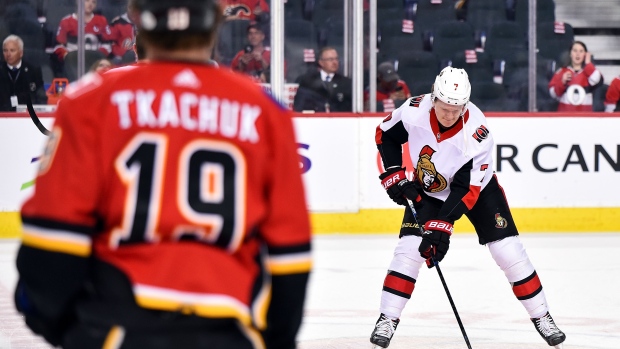
After handing out grades for the centre and defensive positions across the seven Canadian clubs, our focus turns to the wings.
Of all the positional groups, the wing is the trickiest because it’s also the most fluid. Most teams will use a dozen or more different wingers over the course of the season – some of that via promotion from developmental clubs and some of that from moving positional centres to the wing. But we do have reasonable expectations of what opening night should look like for each team.
The good news for the Canadian clubs is that the winger position is generally one of strength, with several impressive prospect pipelines to boot.
To the teams!
Vancouver Canucks (A-)

The Canucks have a tremendous luxury in the form of J.T. Miller, a player who can seamlessly move between centre and wing for head coach Travis Green. Not only does it allow Miller to move around the lineup, but it also affords Green the option of pairing Miller with Elias Pettersson on the team’s top line.
That’s important for a few reasons. First, the chemistry between Miller and Pettersson has been notable in the offensive zone. Over the past two seasons, the Canucks are averaging 4.3 goals per 60 minutes on the attack with the Miller/Pettersson duo on the ice. For context, the Edmonton Oilers have averaged 3.8 goals per 60 minutes at even-strength with Connor McDavid on the ice.
Second, Miller on Pettersson’s line allows Green to have some flexibility when it comes to the faceoff circle and defensive responsibilities. There has been a lot of talk about Pettersson’s skill in the circle, an area he has struggled in over the past few seasons. How much weight you put into the value of winning faceoffs may vary, but Miller winning 54 per cent of his draws – to say nothing of the point-per-game pace he has managed in Vancouver – makes it difficult to drop him in the lineup.
Beyond Miller and his position classification, the Canucks have a healthy number of options at the wing position. Brock Boeser and Conor Garland have been top-six-calibre scorers for years now, and additional help may be on the way.
Nils Hoglander, 20, was electric at times during his rookie season, with 27 points in his 56-game debut. And another big prospect is on the way in 20-year-old Vasili Podkolzin. The 10th overall pick in the 2019 draft is on his way over from SKA St. Petersburg of the KHL. The development of these two young players should ultimately shape what the Canucks end up doing with Miller and, more importantly, gives the Canucks more scoring options away from their first line.
There is an awful lot to like with this group. It is the opposite of what looks like a dire situation on the blueline; they are already teeming with talent, and more help is on the way.
Calgary Flames (A-)

The Flames have been loaded at the wing position for some time, in large part because they hit on two key picks – the Flames grabbed Johnny Gaudreau in the fourth round of the 2011 draft, then Matthew Tkachuk in the first round in 2016.
Gaudreau and Tkachuk have anchored this team for years and are tremendously difficult to deal with – if Gaudreau’s playmaking and on-ice vision from the outside-in is the fuel, then Tkachuk’s frenetic and hyper-aggressive play working the interior of defences is the tinder.
That’s what made Calgary’s approach to the summer doubly interesting. For years Calgary has tried to find the right centres to complement their winger talent, to varying degrees of success.
This year, they opted to use a sizable amount of cap space to add Blake Coleman, signed to a $4.9-million AAV contract through the 2026-27 season. Coleman’s been a capable middle-six scorer for a few years now, highlighted by a 22-goal season with the New Jersey Devils in 2018-19, and a 31-point season with the Tampa Bay Lightning a year ago. If we assume the Flames will preserve the Gaudreau and Tkachuk tandem on the top line, it’s likely Coleman will slide into second-line duty with names like Sean Monahan and Dillon Dube.
The one player I think deserves a bit more attention outside of the local market is Andrew Mangiapane. Advanced statistics love Mangiapane, and so do traditional stats: no player has driven a more favourable goal differential (+0.3 per 60 minutes) over the past two seasons, and that’s on a base of a middling 90.9 save percentage behind him.
I remain intrigued by the shot profiles of the Flames with Mangiapane on the ice – he’s played an ample number of minutes with the now-departed Mark Giordano behind him, but it’s clear the Flames are effective at minimizing defensive-zone pressure with him deployed in a way they are not in most other situations:

If Mangiapane sustains this for another season, I suspect we will be talking about him as one of the league’s premier defensive forwards. Perhaps we already should be.
Toronto Maple Leafs (B+)
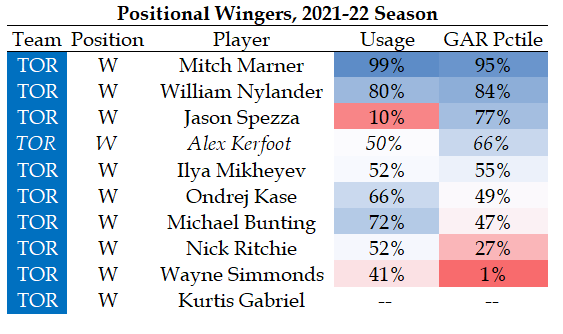
It seems by design that the Toronto Maple Leafs targeted several versatile forwards to fill out their roster – players who can play centre minutes and seamlessly slide out to the wing if the situation calls for it. That’s true for Alex Kerfoot (who should see time in both spots this year), Jason Spezza, and Pierre Engvall.
Between the playmaking ability of Mitch Marner and the two-way play of William Nylander, the Maple Leafs know their top six – always centered by one of Auston Matthews or John Tavares – is going to be tough to match up against for most teams.
We expect to see a healthy serving of Marner once again on Matthews’ line; similarly, Nylander seems ripe for second-line duty with Tavares. And those wingers can be flipped seamlessly when the moment calls for it.
Where the intriguing part of the roster competition will come into play is for the other two winger spots. Head coach Sheldon Keefe seems to like a complementary player (especially for forechecking and board work) on the Matthews line, and that’s why you are seeing names like Michael Bunting and Nick Ritchie identified as top-six options. Ilya Mikheyev also seems a candidate for top-six minutes, but a recent trade request may cloud those waters.
I’ll also be paying close attention to Spezza. He has unequivocally defied the aging curve for a moment of time here – Spezza didn’t look any part of 37-years-old last season, in large part because the Maple Leafs figured out a way to manage his minutes and put him in positions where he can make plays against lesser competition and in spot minutes on the second power-play unit.
Winnipeg Jets (B+)
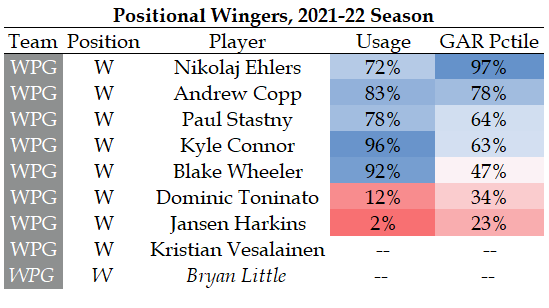
At one point, the Winnipeg Jets were deep at the wing position. That’s not the case heading into next season. On the heels of trading Patrik Laine for centre Pierre-Luc Dubois and likely losing Bryan Little to long-term injured reserve, the Jets have had to rebuild the position on the fly.
The good news is the top half of the lineup remains intact, and that’s where a lot of Winnipeg’s firepower comes from.
Nikolaj Ehlers and Kyle Connor are entrenched top-six wingers and were exceptionally productive on the attack last season – Ehlers managing 46 points in 47 games, Connor with 50 over the full season. Perhaps the most interesting part of their production last season is it came despite a down season from Dubois, who was a common fixture on both lines (37 and 30 per cent, respectively).
How head coach Paul Maurice fits these pieces together will be worth watching. If we assume Maurice keeps the Ehlers and Mark Scheifele tandem together, and we assume the preference is to keep Dubois as a second-line centre, then there are three pieces – including the aforementioned Connor, as well as Blake Wheeler and former centre Paul Stastny – to flow in the remaining positions. No matter what way you slice that group, they should be formidable.
The bottom six is where things are going to get dicey. Andrew Copp has become a heavy-usage weapon for Maurice, in large part because no player has driven more favourable goal differentials than Copp (+17) over the past three seasons. Beyond Copp, the Jets will look to depth veterans and Kristian Vesalainen, a 22-year-old Finnish rookie who saw 12 games of action last season, for big step-up efforts.
At any rate, it’s a very unproven bottom six, and may put more of a burden on the big guns in the Jets lineup to deliver.
Edmonton Oilers (B+)
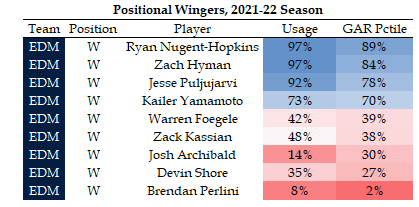
Similar to the Vancouver Canucks and the positional versatility of Miller, the Oilers can do an awful lot with the top half of their lineup.
Both Leon Draisaitl and Ryan Nugent-Hopkins can play on the wing, and with Connor McDavid assured to anchor the team’s top line for the foreseeable future, the Oilers can build out a deadly first or second line by merely moving one of their centres outside, as they have done for a couple of years now. For the sake of consistency, we will consider Nugent-Hopkins the winger here.
The most notable change at the wing position for the Oilers is Zach Hyman, signed to a lucrative seven-year deal this off-season. There remains ample debate about the length and magnitude of the contract Hyman signed – it’s quite frankly rare to see a player with a muted track record of goal-scoring at the age of 29 sign a contract this sizable, but Hyman is also a unique player.
Few forwards around the league are as strong away from the puck on both ends of the ice. He’s an elite puck-retriever, a forechecking dynamo, and has the size and tenacity to break attackers away from the puck in the defensive zone. Hyman, particularly if he plays on the top line with McDavid as expected, will significantly improve this team’s outlook in the short term.
Hyman’s spot in the lineup also has a compounding effect. In the last two seasons, Kailer Yamamoto and Jesse Puljujarvi (post-return from Karpat in SM-liiga) both showed they could handle middle-six minutes. The McDavid/Puljujarvi duo last season outscored opponents 42 to 33 (+9) at even strength; the Draisaitl/Yamamoto tandem outscored opponents 32 to 16 (+16) in their second-line duty. There’s little doubt which players are driving the bus here, but it’s good to see Puljujarvi’s defensive touch and Yamamoto’s ability to set up shooters in the offensive zone act as important complementary attributes.
The big question, as it always tends to be in Edmonton, is what the third and fourth lines will look like. The Oilers need to sort out some competition for the fourth-line centre position before they can build out the rest of the combinations, but I’ll be paying careful attention to Warren Foegele, a wrecking ball on the ice when he’s healthy.
Foegele brings sheer tenacity and straight-line play you want to see further down the lineup – the archetype of a player the Oilers haven’t had in years.
Montreal Canadiens (B)
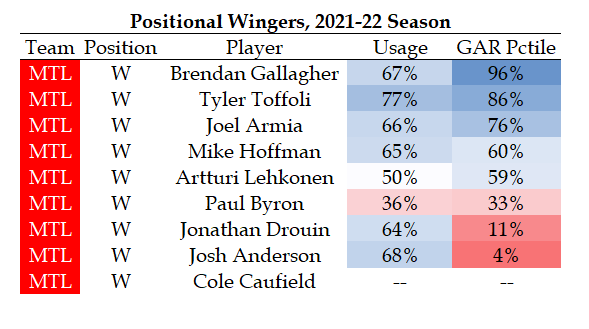
The Canadiens enter next season with an impressive rotation of top nine-calibre wingers. But ultimately this position will be defined by two players: Brendan Gallagher, and Cole Caufield.
Gallagher has been the heart and soul of this organization for quite some time, and an effective one at that. In Gallagher’s prime years, he was incapable of being pushed out of the net-front, generating heaps of scoring chances off rebound opportunities and causing general chaos in front.
Gallagher’s ability to frustrate interior defenders and goaltenders still exists in spades, but durability concerns are starting to appear. He has missed time in the last two seasons (concussion; broken thumb) and played through a groin injury in the playoffs.
The good news for Gallagher? So far, production hasn’t slowed. Gallagher has played at a 30-goal-per-82-game pace for most of his career, and last year’s 14-goal campaign would have been good for 33 over a full season. If Gallagher can stay healthy, there’s no reason to think his game will taper off right now.
But Gallagher is 29 years old. If he is the present, Cole Caufield is the future. We caught a glimpse of Caufield in the postseason and he was as advertised – an undersized attacker who is a threat in transition and may already be the best sniper on the team.
Caufield managed 12 points in 20 playoff games last season, and most importantly, found instant chemistry with centre Nick Suzuki. Expect head coach Dominique Ducharme to keep this duo together and underestimate their scoring potential at your own risk.
One other note of interest: Paul Byron, a very effective bottom-six winger and penalty killer, is out long-term following hip surgery.
Ottawa Senators (B-)
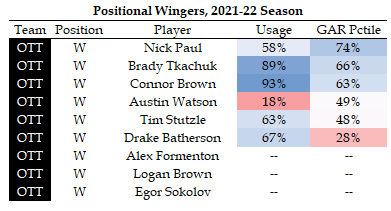
Absent Brady Tkachuk and Connor Brown, the group is largely unproven at the NHL level. And yet, like most positional groups in Ottawa, the potential for big upside with a number of these players – considering their draft pedigree, how they have produced at junior or other professional levels as they attempt to transition to the NHL – is encouraging.
Two contract situations are worth mentioning here. The Senators were able to ink the speedy Drake Batherson to a six-year deal, locking him in through his age-29 season. Batherson just wrapped up his first professional season and was a big bright spot on an otherwise awful team. His 34 points in 56 games was just two in trail of the team lead (Tkachuk), and his rate goal scoring (1.1 per-60 minutes) was second on the team to Brown (1.2).
Any time you have a gifted first-year prospect near the top of your scoring list, it’s a significant development, and I think Ottawa was reasonably willing to gamble that future trajectory would similarly be positive.
Less encouraging is the contractual stalemate between the Senators and Tkachuk, who is the face of the franchise at this point of his career. The Senators may have a lot of players with promising futures, but the immediate outlook for this team based on the talent is still poor, and only a few rostered players are surefire bets to produce next year. Tkachuk needs a new contract immediately, and the longer this goes on, the larger the ramifications are for the team next year.
One closing point here: 21-year-old Egor Sokolov is a name that garnered a lot of attention last week. Sokolov is fresh off an impressive development camp and spent stretches of the off-season training with the likes of Sidney Crosby and Nathan MacKinnon. This follows up some blistering scoring with the Cape Breton Eagles in the QMJHL from 2017-20. If there is a player with an outside shot of stealing a roster spot, it’s probably him.
Data via Natural Stat Trick, Evolving Hockey, Hockey Viz, NHL.com

